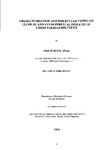CHARACTERISATION AND MOLECULAR TYPING OF CLINICAL AND ENVIRONMENTAL ISOLATES OF VIBRIO PARAHAEMOLYTICUS
| dc.contributor.author | Miah, Aklak | |
| dc.contributor.other | Faculty of Science and Engineering | en_US |
| dc.date.accessioned | 2013-10-03T08:54:29Z | |
| dc.date.available | 2013-10-03T08:54:29Z | |
| dc.date.issued | 2009 | |
| dc.identifier | NOT AVAILABLE | en_US |
| dc.identifier.uri | http://hdl.handle.net/10026.1/1977 | |
| dc.description.abstract |
Vibrio parahaemolyticus is a natural inhabitant of coastal waters worldwide and is the leading cause of seafood-borne gastroenteritis. This study reports on the use of several molecular characterisation methods to screen clinical and environmental isolates of V parahaemolyticus to assess whether such techniques can be used to distinguish pathogenic isolates reliably. In a total of 86 isolates mainly of V parahaemolyticus but also including V cholerae, V vulnificus and several other species, serotypes of the more virulent clonal group 03:K6 were identified, but otherwise there appeared no association with serotype and phenotype. The tdh and trh genes encoding haemolysins that are typically associated with virulent isolates were found in a significantly large number of isolates; however, poor concordance between haemolytic activity and the presence of the gene tdh was found. In an effort to establish more accurate relationships amongst clinical and environmental isolates of V parahaemolyticus, four molecular typing systems were employed; namely pulsed-field gel electrophoresis (PFGE), intergenic transcribed spacer (ITS) analysis, tDNA intergenic length polymorphisms (tDNA-ILPs) and randomly amplified polymorphic DNA (RAPD). Typing patterns and clustering analysis using these methods differentiated V parahaemolyticus from other marine species as well as at the subspecies level. PFGE with NotI was shown to be the most discriminative but suffered from not being universally applicable. Both ITS and tDNA-ILP methods were sufficiently discriminatory with discrimination indices (DI) of between 0.568 and 0.724, depending on the primers employed. The discriminatory ability of RAPD was also affected by the primers used (DI= 0.959 - 0.965) but closely matched that of PFGE (DI = 0.976). Additionally, both RAPD methods were able to distinguish putative markers for the pandemic clonal group. Typing systems appeared largely stable in duplicate and triplicate analyses with multiple primer pairs with some obvious variability in the reproduction of faint amplicons. All methods except PFGE were simple to execute but none of the methods could distinguish V parahaemolyticus into obvious lineages based on the clinical or environmental source. With the recent implication of a type Ill secretion system {TTSS) involved in the pathogenicity of V parahaemolyticus, a multiplex PCR system using PCR primers that spanned both TTSSl and TTSS2 regions was developed. Dot-blot analysis confirmed TTSS2 genes in at least 30% of environmental isolates. Nucleotide sequence analysis revealed l00% sequence homology in three loci of TTSS2 putative structural genes. In comparison, a total of 34 single nucleotide polymorphisms (SNP) were identified in three TTSS1 regions. In two of the regions, the SNPs were synonymous, whereas a non-synonymous substitution in the structural gene vcrDI resulted in valine replacement with isoleucine. In addition, nucleotide deletions in TTSS1 with resultant frameshift mutations were identified. The finding that significant numbers of environmental isolates also possess TTSS2 genes is contrary to currently held opinion that TTSS2 is only present in clinical isolates. It is hypothesed that the high incidences of V parahaemolyticus infections may be related to active TTSS2 genes, whereas a high degree of polymorphisms in TTSS1 suggest it may be inactive. | en_US |
| dc.description.sponsorship | The Centre for Environment, Fisheries and Aquaculture Science Weymouth Laboratories, Dorset, United Kingdom | en_US |
| dc.language.iso | en | en_US |
| dc.publisher | University of Plymouth | en_US |
| dc.title | CHARACTERISATION AND MOLECULAR TYPING OF CLINICAL AND ENVIRONMENTAL ISOLATES OF VIBRIO PARAHAEMOLYTICUS | en_US |
| dc.type | Thesis | |
| plymouth.version | Full version | en_US |
| dc.identifier.doi | http://dx.doi.org/10.24382/1433 |
Files in this item
This item appears in the following Collection(s)
-
01 Research Theses Main Collection
Research Theses Main


